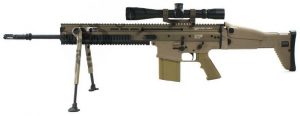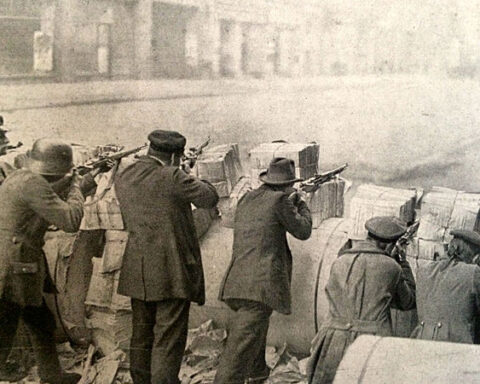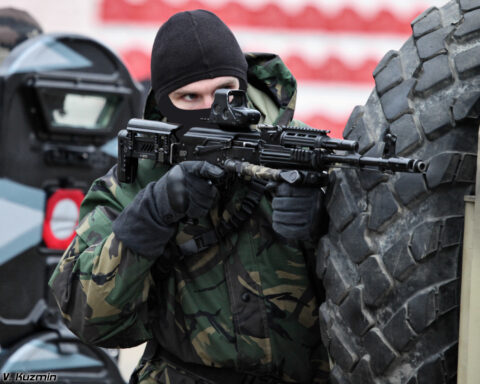Recently, a commentator asked a darn good question: “HOW MUCH BATTLE RIFLE DO I NEED?”
You want to be prepared for all sorts of contingencies, from minor bumps in civilization to full-on invasion of the Mi-go and their quisling human servants.
So what rifle should you have to tackle everything?
Short answer: There isn’t one.
Shorter: It depends.
Before we get too far into the subject and I piss everyone off at once, there are roughly five types of rifles on the modern battlefield. There’s overlap between the categories in terms of features and specifics, but these five are good enough. Note, I’m not talking about crew-served weapons, light or heavy machine guns. I’m talking about what your standard grunt would be using, and ones that, as a civilian, you should know about and look for their non-military counterparts.

Automatic rifle. The rifle will continue to fire as long as the trigger is held down and the magazine isn’t empty. WWI saw these rifles becoming important tools on the battlefield. The Browning Automatic Rifle saw it’s debut and was the standard until after WWII as the squad light automatic rifle. The German counterpart to the BAR was the FG 42, which influenced firearm designs post-WWII.
 Assault rifle. These are automatic rifles that use an intermediate cartridge with a detachable magazine. What are intermediate cartridges? I’m glad I asked. Originally, bigger, heavier rounds were used in the Automatic Rifles. The BAR, for example, was chambered for the .30-06 Springfield. Needless to say, recoil and control were big issues. So the intermediate cartridges were designed to make automatics easier to handle. Additionally, most combat interactions happen between 150 to 300 yards. The bigger cartridges were unnecessary for the average troop. WWII saw the widespread use of intermediate cartridges, from the German 7.92×33mm Kurz, the Soviet 7.62×39mm for the AK47. After WWII, the (in)famous NATO 5.56x45mm came out of the 60s. Basically, these are designed to punch hard but still be controllable for automatic rifles.
Assault rifle. These are automatic rifles that use an intermediate cartridge with a detachable magazine. What are intermediate cartridges? I’m glad I asked. Originally, bigger, heavier rounds were used in the Automatic Rifles. The BAR, for example, was chambered for the .30-06 Springfield. Needless to say, recoil and control were big issues. So the intermediate cartridges were designed to make automatics easier to handle. Additionally, most combat interactions happen between 150 to 300 yards. The bigger cartridges were unnecessary for the average troop. WWII saw the widespread use of intermediate cartridges, from the German 7.92×33mm Kurz, the Soviet 7.62×39mm for the AK47. After WWII, the (in)famous NATO 5.56x45mm came out of the 60s. Basically, these are designed to punch hard but still be controllable for automatic rifles.
 Battle rifle. This category is more recent and doesn’t have much usage in military designations, since all rifles are battle rifles for the military. The basic idea is to have a rifle that shoots a full-power rifle cartridge for greater range at the expense of automatic fire. The M14 rifle falls into this category. More punch than the M16, which followed it, more features than the MI Garand, which it replaced.
Battle rifle. This category is more recent and doesn’t have much usage in military designations, since all rifles are battle rifles for the military. The basic idea is to have a rifle that shoots a full-power rifle cartridge for greater range at the expense of automatic fire. The M14 rifle falls into this category. More punch than the M16, which followed it, more features than the MI Garand, which it replaced.
 Marksman rifle. The Designed Marksman Rifle, the DMR, covers a wide range of different rifles. They fall in between the assault rifle and the sniper rifle in terms of range and power. While most assault rifles reach out to 300 yards as their typical range, the DMR is designed to go past 300 and up to 1,000 yards. Most sport better optics than a standard assault rifle, swing out bipod for stability and are usually semi-automatic.
Marksman rifle. The Designed Marksman Rifle, the DMR, covers a wide range of different rifles. They fall in between the assault rifle and the sniper rifle in terms of range and power. While most assault rifles reach out to 300 yards as their typical range, the DMR is designed to go past 300 and up to 1,000 yards. Most sport better optics than a standard assault rifle, swing out bipod for stability and are usually semi-automatic.
 Sniper rifle. When you need to reach and touch someone from far, far away but an artillery strike is a shade too much. While the DMR is maxing out around 1,000, the sniper rifle is just stretching its legs. The longest confirmed kill is 2,707 yards, by Corporal of Horse (CoH) Craig Harrison, using L115A3 shooting .338 Lapua Magnum. In this is class are also the anti-materiel rifles, like the .50 BMG. These are designed to break the other side’s lightly armored toys by a small team for 2-3 people.
Sniper rifle. When you need to reach and touch someone from far, far away but an artillery strike is a shade too much. While the DMR is maxing out around 1,000, the sniper rifle is just stretching its legs. The longest confirmed kill is 2,707 yards, by Corporal of Horse (CoH) Craig Harrison, using L115A3 shooting .338 Lapua Magnum. In this is class are also the anti-materiel rifles, like the .50 BMG. These are designed to break the other side’s lightly armored toys by a small team for 2-3 people.
The AR15 is the civilian version of the M16 assault rifle. The biggest change it does not support automatic fire.
So how much rifle do you need? It depends on your goals and needs.
The AR-15 fits well for most needs and there’s a billion aftermarket parts for it. The 5.56 is a good round. If you have already determined the AR15 isn’t going to fit your needs, the .30-06 and .308 chambered rifles are the next ones I recommend evaluating. There are better cartridges on the rise, like the Hornady 6.5 Creedmoor, that are offering BETTER* ballistics as the .308 with less recoil. Still, the .308 is a good starting point, they are easy to find and tons of support for handloader and data.
I recommend starting with the AR15. The 5.56 cartridge is light enough you can shoot it all day and not feel like you’ve been in a cement mixer. It’s versatile, easy to upgrade and maintain, an overwhelming amount of parts available, and popular. Which means if the lizard-people crush human civilization and set up a despotic rule, you and your ragtag group of rebels can find AR15 parts scattered across what was formerly the USA, allowing you to maintain your workhorse rifle under hostile conditions.
Of course, after you have that down, it’s a good idea to consider something with more oomph behind the cartridge. Or, to open another can of worms, a shotgun for getting more close and personal.
*My mistake, the newer cartridges have better ballistics than the old .308.







6.5 creedmore: BETTER ballistics than the .308 with less recoil. Most competitive shooters have moved on to the 6mm creedmore, which was a wildcat but Hornady is introducing it as a factory cartridge this year. Biggest downside to these rounds would be ammo cost.
I agree, start with an AR-15. Ammo is cheapest for it. By the time you learn to shoot it well, you will have learned enough to know what you want to buy next IF you decide to upgrade. I’m pretty excited about the Savage AR’s coming out this year.
Second choice would be something like the Mossberg MVP, or a savage. The MVP is compatible with AR10 magazines.
“BETTER ballistics” Oops, yes, good catch. My apologies.
I am looking at an AR-10 myself. Savage’s MSR will come in 6.5 creedmore. But I may not get it in that chambering.
.308 is a more powerful round, and while an AR is long range capable, as a “battle” rifle, it is going to be a short to mid range platform.
Brass and bullets will also be cheaper.
So I hear the siren song of the 6.5, but I think the .308 is a smarter choice.
It’s hard not to seriously consider the .308 from its long history of being useful and the support that’s out there for it.
An AR-15 or M-16 has a lot to recommend it, both as a starter and your main rifle but the 5.56 is lighter than a lot of folks are happy with. At shorter ranges the 300 Blackout might prove to be a good addition. You can buy just the upper assembly and use it on your existing lower. If you should run out of 300 ammo, just swap back and you can shoot your 5.56.
Not recommending, just a place to start looking:
http://www.radicalfirearms.com/category-s/1854.htm
Buy a rifle. Any rifle. Then focus on the software, not the hardware.
Then upgrade each as necessary.
Glad my question started a conversation. I have a nice SIG AR15 and we have a local group that broke away from the Appleseed folks. They offer AR and pistol training with movement and shooting from cover and such at very competitive prices (Thunder Ranch, are you guys KIDDING ME?) I hope to get myself much MOAR TACTICAL by the end of this fall.
.300 Blackout scares me. I guess some of the factory .300 loads WILL load into battery on a .223. I just know I’d end up with me or someone else loading a round into my AR.
It was a damn fine question with no single answer.
Stick with the tried and true to start, then branch out.
“MOAR TACTICAL” Just make sure it’s not MOAR MALL-NINJA TACTICOOL and you’re good.
Good essay Bo. My past military experience shows that the terrain you occupy should mandate what caliber / firearm you choose. Live in a rural or open suburban area? Then you should be looking at a longer range round like .308 / 7.62mm NATO or .30-06. Live in a dense suburban or urban area? Then 5.56mm or 7.62x39mm. Example – an AR-15 in a dense suburb, a FN-FAL in a rural area.
I have a variety of arms for personal use, but I also saw the wisdom of having “arm-the-family-and-neighbors” firearms on hand. I elected to go with carbines in a pistol caliber made by Hi-Point.
Why?
– The carbines are inexpensive, (around $300 each) so I could buy a bunch of them (five so far).
– the 9mm ammo is cheap and readily available
– the carbines are durable, have an excellent reputation and lifetime warranty
– the lower-powered cartridge is easier for new shooters and the small-statured with less recoil
– the carbine is easy to handle with a short barrel and is generally uncomplicated
– made in the USA
And, yes, I’ve considered and understood the arguments about why this solution isn’t the “best,” but compromises sometimes need to be made. This solution is designed for one purpose: to put an easy-to-manage, inexpensive firearm into the hands of those around me who don’t have something better of their own. If a fortified opponent shows up, they can be slinging lead to keep the opponent occupied while heavier arms are brought to bear.
In an ideal world, everyone would have a battle rifle, side arm and grenades, and an endless supply chain, but this ain’t an ideal world. Actually, an ideal world would include mortars as well.
Good point.
I’m a fan of the SKS, too, for similar reasons. It’s a heavy, old rifle that if I have to give to some one, I know it’s going to fire every time he pulls the trigger and the round has decent heft to it.
5
It doesn’t matter what you have if you’re by yourself. Saying that, get a mil spec ar15, at least 20 magazines, a good chest rig for carrying mags, about 5000 rounds of ammo for training, plus at least three more people. That equals you and three close friends or neighbors, preferably ones who live close. People you trust. If you have no one else get out there and start cultivating friendships. Now, get some professional training and learn how to fight together as a team. Oh, don’t forget PT.
Yes. Keep watching the blog. We have plans in the works: https://www.menofthewest.net/the-four-pillars-for-individual-combat-effectiveness/
Thanks, I’m new here, and I will.
1.5
3.5
Rule #1. have something! Pump shotguns are a good starter. 20ga, 16 ga. Your neighborhood situation might need to be considered, so slug or shot? I’ve a family member who travels for work and he bought his wife a 16 gauge pump and Instructor sessions. She turned out to be a natural and takes the thing wherever they travel (driving) and can break it down better and faster than I can with mine, and I’m “the gun guy”.